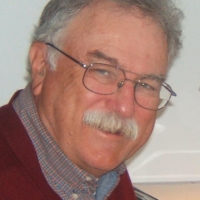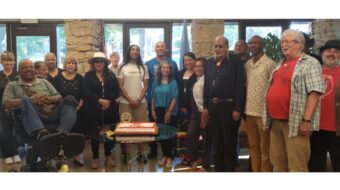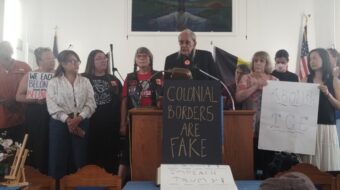
SUQUAMISH, Wash. — “Paddle to Suquamish” Aug. 1-11 was a dramatic sign that the Indian tribes of the Pacific Northwest are in the midst of a cultural reawakening.
Participation continues to grow 20 years after “Paddle to Seattle,” the first tribal canoe journey in 1989 commemorating the 100th anniversary of the founding of Seattle. This year, delegations of Native Hawaiians, and Maoris from New Zealand joined “Paddle to Suquamish.”
There is high romance in the mostly youthful Indian “pullers” pitting their strength against winds, tides, and currents in cedar dugouts like the graceful canoes that once plied these waters. Suquamish was turned into a tent city as thousands converged for the celebration. Chief Seattle is buried here and a steady stream of people made their way to his grave site in the cemetery at St. Peter Mission Catholic Church. The skyscrapers of the city named for him loomed in the haze 20 miles away across Puget Sound.
The Suquamish have built a magnificent new long house near the site of “Old Man House,” the 600 foot cedar plank long house that was once home to the Suquamish people. It was the center of trade, lodging, meetings and ceremonies. Sometime between 1870 and 1872, the Bureau of Indian Affairs agent assigned to the Suquamish Reservation burned the long house “in an attempt to discourage the communal lifestyle of the tribe,” reports Noel Purser in his story, “Bringing Back the Canoe: A Suquamish Story.” His story is the main feature in the program distributed to everyone who attended the five day celebration.
Purser adds, “Despite attempts by the federal government to annihilate Suquamish people and culture….the tribe has persevered. We retain much of our rich heritage—cultivated and passed through countless generations living along the shores of the Puget Sound.”
The Hawaiians brought their own double-hulled vessel, modeled after a Polynesian outrigger and traveled together with the Suquamish to many Indian towns around Puget Sound. In their “protocols,” performed in the new long house, they sang a song translated from Hawaiian by one of the women singer-dancers: “The land has been taken away. We value the land itself and not the things that are built on the land. We don’t care about the wealth, all America’s piles of money. What we care about is the land itself.” The crowd erupted in a deafening cheer at this translation. Kaleo Wong, one of the young Hawaiians, told the World the song “is about the overthrow of the Hawaiian Nation by five U.S. businessmen backed by the U.S. Navy,” more than a century ago.
Mary Kay Leitka, an elder of the Chalaat tribe of the Hoh River rainforest on the Olympic Peninsula, was in Suquamish with several of her offspring including granddaughter Marianna. “She is a weaver like me,” Leitka told the World, wrapping her arm around the young girl’s shoulder. “There was a time we thought we had lost that culture, the songs, the dance, the basket weaving. But my mother told me, ‘We’re going to come full circle. Everything we have in our teachings and our culture will meet together.’ And she was right. Here we are. I’m a weaver with cedar, bear grass and sweet grass. I learned basket weaving from my mom who died in 1986. I have seven daughters. Two of them are weavers.”
She added, “The unity here is important. We’re all together, one family. That’s the way it ought to be.”
She was born in Lapush, Washington, a member of the Quileute tribe. They were stripped of their right to fish for salmon and steelhead trout, the staple of their diet, in the river that ran through their mile-square reservation, she said. “The Hoh people also had to fight for their fishing rights.”
They won victories in the courts, she said, culminating in the historic ruling by Judge George Boldt Feb. 12, 1974 upholding the tribes’ right to half the annual catch of salmon.
She went to Washington D.C. and met once with Washington State’s notorious enemy of Indian rights, Republican Senator Slade Gorton. He was still trying to reverse the Boldt decision 20 year after it was handed down. “I told the Senator, ‘Mr Gorton, I’d appreciate it if you would sit down and listen. You’re the man who can do something about the steelhead.’ And he did sit down. I said to myself, ‘My God! I told a Senator to sit down!’” She laughed merrily at the memory. The Native American Indians played a major role in defeating Slade Gorton in the 2000 election.
She spoke of the tragedy of grandparents dying too young. “My grandfather was the only one of my grandparents alive when I was little. What happens to a people’s memories when the grandparents die so young? I’m 61 years old. I’m handing all of my memories down to my children and grandchildren. We tell our grandchildren and great grandchildren: ‘visit your elders. Learn the songs.’”
That was a theme everywhere in this year’s tribal journey. At Hollywood Beach in Port Angeles, Sam Adams and seven crewmates were welcomed ashore after paddling from Ahousat, a village on the west coat of Vancouver Island, B.C. “The water was smooth but it was very hot,” Adams told the World. “We’ve been on the waters for a week now.” He said it is his fourth tribal canoe journey but this one was special because he brought with him his grandson Aaron Whitmire. “It is his first time but I hope the first of many,” he said. “I have made many friends over the years. It is really good to get people together.”
A week earlier, in Neah Bay, the Makah Indian village in the farthest northwest corner of the lower 48 states, the tribe was preparing to leave on the tribal journey. The Makah were legendary whalers, venturing far into the Pacific in their cedar dugouts. Polly Debari, a Makah tour guide, told this reporter her entire family was preparing to participate in “Paddle to Suquamish.” “”My six kids have all grown up in the Tribal Canoe Journeys,” she said. “They are going to be able to negotiate together because they are all friends. They all paddled together.”
Photo: Tim Wheeler/PW










